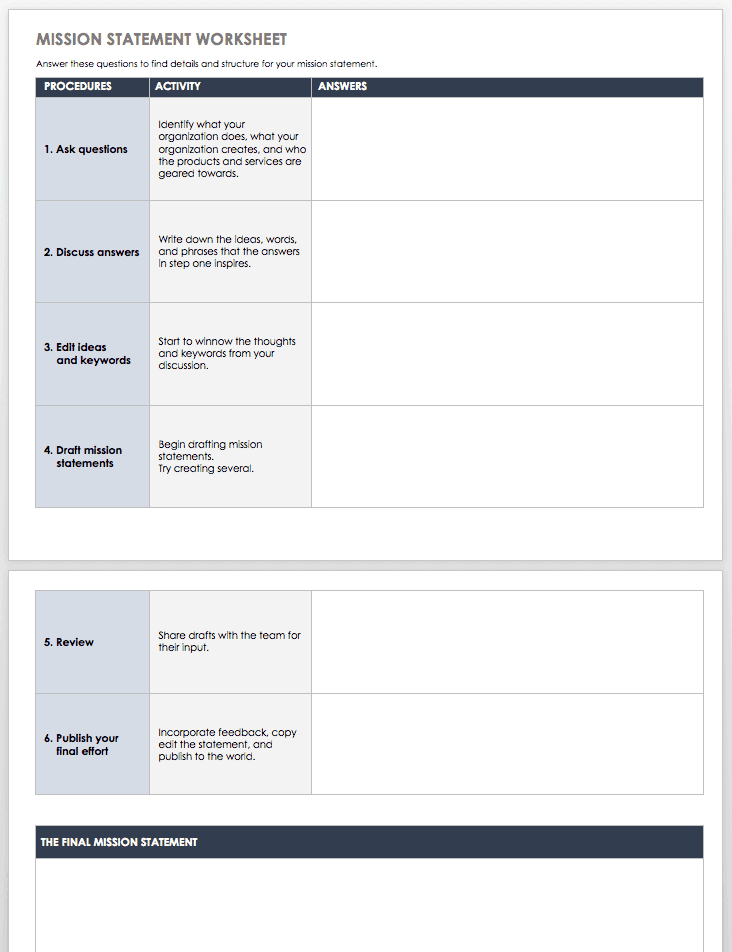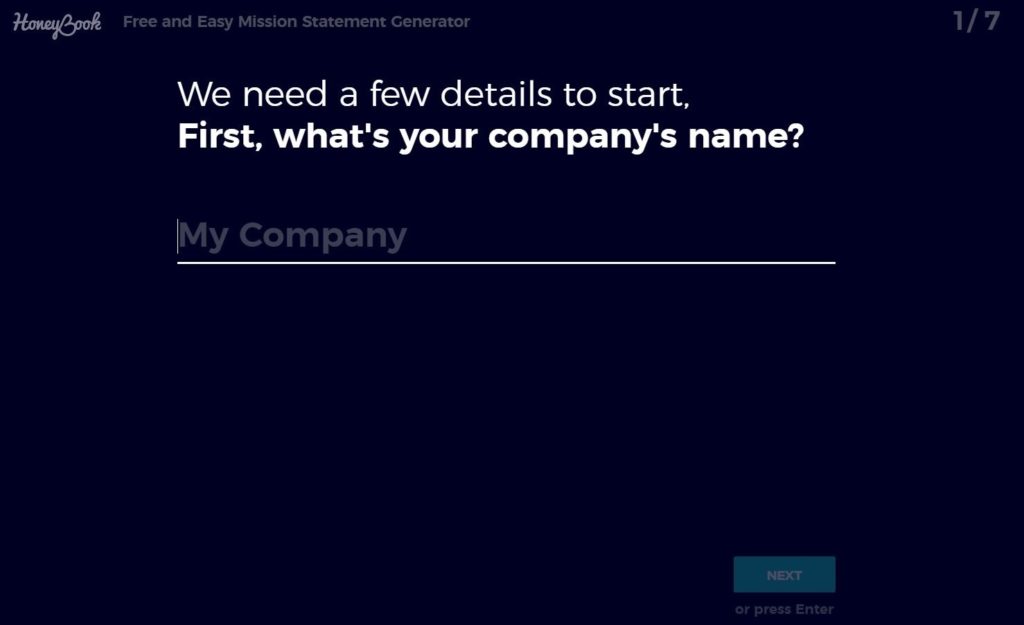Running a successful business takes more than ambition—it takes focused planning, clear objectives, and a strong sense of purpose. A critical early step is defining your goals and clarifying why your business exists in the first place.
Two tools anchor that clarity: your mission statement and your vision statement. They’re often confused because both point to direction, but they serve distinct roles that shape your day-to-day execution and your long-term strategy.
A mission statement explains what your business does right now; a vision statement describes where you want the business to be in the future.
In this guide, you’ll learn why vision and mission statements matter, how they differ (and complement each other), and practical steps to write strong, memorable statements for your business.
What is a Vision Statement?
A vision statement is a concise, inspirational description of the future you’re building. Think of it as your North Star—the long-term change you want to create and the impact you hope your business will have on customers, your industry, and the world.
Done well, it guides strategic decisions, sets the tone for the company’s direction, and communicates a purpose that transcends day-to-day operations.
In short: your vision is a bold declaration of what you want to become. It aligns your team around a shared destination and motivates them to move toward it every day.
- What are your biggest dreams and long-term aspirations for the business?
- What positive change do you want your company to spark?
- Which problems will you be proud to have solved—for customers or for society?
Although your vision describes the future, it’s usually written in the present tense to make it feel immediate and inspiring. Keep it values-driven and vivid enough that people can picture success.
What is a Mission Statement?
A mission statement explains your company’s core purpose, audience, and primary activities in plain language. It states what you do, who you serve, and how you deliver value—today.
If the vision is where you’re going, the mission is how you’re getting there. It translates strategy into everyday actions and priorities so teams stay aligned with the long-term goal.
Use these prompts as you draft your mission:
- What do we do, and why does it matter?
- Who are our customers or audience?
- How do we create value for them consistently?
Mission statements often begin with “We provide…” or “We help…”. A good one becomes a benchmark for decisions, unifies the team, and guides how work gets done.
The Basics of Vision and Mission Statements
Understanding how mission and vision relate helps you craft both effectively. The two statements are different—and complementary.
Vision Statement vs. Mission Statement
Both are essential, but they serve different functions.
The vision focuses on the future—the impact you want to make and the change you seek to create. The mission focuses on the present—what you do today, who you help, and how you deliver value.
Put simply: the mission covers the what and how; the vision captures the why and where.
Consider Google’s statements:
Vision statement: “To provide access to the world’s information in one click.”
This expresses a clear future-focused aspiration—broad purpose and desired impact.
Mission statement: “To organize the world’s information and make it universally accessible and useful.”
This reflects current, ongoing activity—the everyday work that moves Google toward its bigger vision.
Together, the mission explains the plan; the vision explains the destination.
Collaborative Working
These statements aren’t window dressing—they steer teams, shape culture, and drive growth. To write them well, you need clarity on both long-term aims and near-term priorities.
Used together, the mission and vision form the foundation of strategy. They align efforts, simplify decisions, and keep everyone pulling in the same direction.
Well-crafted statements also attract the right talent and keep employees focused and motivated. Vague statements do the opposite—creating confusion, misalignment, and drift.
Next, let’s walk through how to draft each statement step by step.
Drafting A Vision Statement
Since your vision defines the destination, it usually helps to write it first. Start by imagining the future you want to create—for your customers, your team, and the world around you.
Revisit core elements of your business plan: elevator pitch, goals, values, SWOT, and brand story. Together, they clarify your long-term purpose and direction.
Then condense that picture into a single, powerful sentence that captures what you’re building toward.
Use these questions to shape your vision:
- What is our ultimate purpose?
- What major problem will we help solve for our audience or the world?
- What lasting change do we want to make?
- What will success look like in 10 years?
- What legacy should our company leave?
Refine your answers. Keep language clear, specific, and energizing—like a great elevator pitch that teams can remember and rally around.
With the destination set, map the route to get there.
Drafting A Mission Statement
Your mission outlines the day-to-day actions that move you toward the vision. It’s the practical “how” behind your “why.” A strong mission acts as a compass for employees and sets expectations for customers.
Prompts to guide your draft:
- What has to happen to make the vision achievable?
- What do we need to do every day to support the vision?
- Who do we help, and what exactly do we do for them?
- What value do we deliver, and how does it improve customers’ lives or businesses?
If you’re unsure, look at customer profiles, buyer personas, and the user journey. That context clarifies how you make a difference and where to focus.
Write a one-to-three sentence mission that’s specific and memorable. Avoid jargon. Aim for 100 words or fewer—the shorter and clearer, the better.
3 Tools to Improve Your Vision and Mission Statement
Crafting strong statements takes time, but you don’t have to do it alone. These tools can speed up brainstorming and help you shape language that reflects your identity and goals.
Market and Vision Statement Templates
There are many free and paid templates available. Most include prompts that help you organize ideas and structure your statements.
For example, Smartsheet offers a mission statement worksheet with prompts and response fields—a simple way to brainstorm and refine.

Vision and Mission Statement Generators
If you’re stuck on phrasing, try a generator such as the HoneyBook mission statement generator. These tools won’t write the final version for you, but they can spark ideas and reveal formats that fit your brand.

Use the output as a draft—then personalize it, tighten the language, and make it unmistakably yours.
Business Plan Services
Since vision and mission statements sit inside your business plan, full-service platforms like LivePlan and Bizplan include guided workflows and expert resources to build them well.
Unlike DIY templates, these tools often pair you with specialists or AI-guided assistance to produce professional, goal-aligned statements and supporting documents.
5 Tricks for Writing a Good Vision and Mission Statement
Use these best practices to write clear, compelling, and actionable statements that align your team and resonate with customers.
Clearly Define Your Future
Host a strategy session with leadership to define your ultimate goal. Ask: Why do we exist? What future are we trying to create? Capture everything, then refine it into a single, vivid vision statement.
Remain in Sync
Your mission and vision should feel connected, not conflicting. Draft the mission using the vision as a guide. Keep language and tone consistent, and ensure both reflect your brand’s personality and purpose.
Make Them Memorable and Achievable
Be ambitious without being unrealistic. Aim for stretch goals grounded in reality. Write statements that people can remember and repeat—because what sticks, guides behavior.
Align Them With Your Goals
Mission and vision should directly support your strategy. When your objectives change—new markets, product shifts, or audience focus—update your statements. Expect the mission to evolve more frequently than the vision.
Think About the Future
Your vision should capture what you want the company to look like in 5–10 years. That forward view also informs the mission—identifying the steps required to make that future real.
For deeper insight, run a gap analysis: compare current performance with your desired future state to spot what’s missing and which capabilities to build next.
Quick Formulas You Can Use
Vision = Audience/World + Desired Change/Impact + Time Horizon (implied).
Mission = Who (customer) + What (problem you solve) + How (your unique approach) + Outcome (value delivered).
Examples by Business Type
Use these sample statements as starting points. Tailor the nouns and verbs to match your brand voice and strategy.
SaaS
Vision: Empower every small team to make data-driven decisions in minutes, not months.
Mission: We provide intuitive analytics tools that automate data prep and deliver clear insights so non-technical teams can act with confidence every day.
Ecommerce
Vision: Make sustainable essentials the default choice for households everywhere.
Mission: We curate planet-friendly products and deliver them with transparent pricing, fast shipping, and helpful guidance for lower-waste living.
Professional Services
Vision: Help every local business become the best-known brand in its neighborhood.
Mission: We provide affordable, done-for-you marketing that grows foot traffic and revenue with measurable results.
Nonprofit
Vision: A world where every student has the resources to thrive in school.
Mission: We mobilize communities to fund classroom essentials and provide mentorship that improves learning outcomes.
Common Mistakes to Avoid
- Being too vague. “Be the best” doesn’t guide decisions. Be specific about audience, value, and impact.
- Confusing mission with marketing. Taglines are optional; your statements should inform choices, not just sound catchy.
- Writing by committee—without a decider. Gather input, but assign final ownership to avoid watered-down language.
- Letting them collect dust. Revisit at least annually (or after major strategic shifts) and adjust as the business evolves.
Quick Checklist
- Vision: Clear, future-focused, one to two sentences, present tense.
- Mission: Specific, present-focused, one to three sentences, customer and value oriented.
- Consistency: Tone and intent align; no conflicts between mission and vision.
- Memorability: People can recall and restate both statements accurately.
- Usability: Statements help you choose projects, say no to distractions, and measure progress.
What to Do Next
Once your mission and vision are written, put them to work. Translate them into specific, measurable objectives that drive daily operations and long-term planning.
Create an action plan or expand into a full business plan. Prioritize initiatives, assign owners, set timelines, and track results. Share your statements widely—on hiring pages, in onboarding, and during planning meetings—so they inform decisions across the company.
Make Them Operational
- Set quarterly goals (OKRs/KPIs) that map to the mission and vision.
- Review new projects against the statements: if they don’t fit, don’t ship.
- Revisit statements after major product, market, or audience shifts.
- Collect customer and employee feedback to ensure the words match reality.
